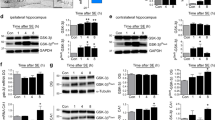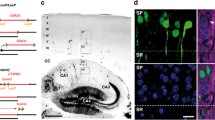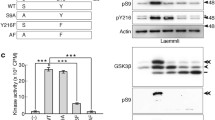Abstract
Down syndrome (DS) is a developmental disorder that results from the trisomy of chromosome 21. DS patients show several abnormalities including cognitive deficits. Here, we show enhanced activation of the extracellular signal-regulated kinase (ERK), a kinase that critically regulates synaptic plasticity and memory, in a hippocampal cell line derived from trisomy 16 mouse foetus. In addition, these cells show enhanced activation of p38 mitogen-activated protein kinase (p38 MAPK). The hyper-activation of ERK and p38 MAPK is significantly reduced by a small peptide, Gly-Pro-Glu (GPE), derived from insulin-like growth factor-1. In addition, the trisomic cells show reduced level of inhibitory phosphorylation of glycogen synthase kinase-3β (GSK-3β), which is enhanced by GPE. Furthermore, the trisomic cells do not show ERK activation in response to KCl depolarization or forskolin treatment. Importantly, ERK activation by these stimuli is observed after GPE treatment of the cells. These results suggest that GPE may help reduce aberrant signalling in the trisomic neurons by affecting MAPK and GSK-3β activation.





Similar content being viewed by others
References
Adams JP, Sweatt JD (2002) Molecular psychology: roles for the ERK MAP kinase cascade in memory. Annu Rev Pharmacol Toxicol 42:135–163. https://doi.org/10.1146/annurev.pharmtox.42.082701.145401
Ahmed MM, Dhanasekaran AR, Tong S, Wiseman FK, Fisher EMC, Tybulewicz VLJ, Gardiner KJ (2013) Protein profiles in Tc1 mice implicate novel pathway perturbations in the Down syndrome brain. Hum Mol Genet 22:1709–1724. https://doi.org/10.1093/hmg/ddt017
Bradley CA, Peineau S, Taghibiglou C, Nicolas CS, Whitcomb DJ, Bortolotto ZA Kaang B, Cho K, Wang Y and Collingridge GL (2012) A pivotal role of GSK-3 in synaptic plasticity. Front Mol Neurosci 5:13. https://doi.org/10.3389/fnmol.2012.00013
Burgos-Ramos E, Martos-Moreno GA, López MG, Herranz R, Aguado-Llera D, Egea J Frechilla D, Cenarruzabeitia E, León R, Arilla-Ferreiro E, Argente J, Barrios V (2009) The N-terminal tripeptide of insulin-like growth factor-I protects against beta-amyloid-induced somatostatin depletion by calcium and glycogen synthase kinase 3 beta modulation. J Neurochem 109:360–370. https://doi.org/10.1111/j.1471-4159.2009.05980.x
Cacciatore I, Cornacchia C, Baldassarre L, Fornasari E, Mollica A, Stefanucci A, Pinnen F (2012) GPE and GPE analogues as promising neuroprotective agents. Mini Rev Med Chem 12:13–23. https://doi.org/10.2174/138955712798868995
Cárdenas AM, Arriagada C, Allen DD, Caviedes R, Cortes JF, Martin J, Couve E, Rapoport SI, Shimahara T, Caviedes P (2002) Cell lines derived from hippocampal neurons of the normal and trisomy 16 mouse fetus (a model for Down syndrome) exhibit neuronal markers, cholinergic function, and functional neurotransmitter receptors. Exp Neurol 177:159–170. https://doi.org/10.1006/exnr.2002.7957
Corvol JC, Valjent E, Toutant M, Enslen H, Irinopoulou T, Lev S, Hervé D, Girault JA (2005) Depolarization activates ERK and proline-rich tyrosine kinase 2 (PYK2) independently in different cellular compartments in hippocampal slices. J Biol Chem 280:660–668. https://doi.org/10.1074/jbc.M411312200
Costa ACS, Grybko MJ (2005) Deficits in hippocampal CA1 LTP induced by TBS but not HFS in the Ts65Dn mouse: a model of Down syndrome. Neurosci Lett 382:317–322. https://doi.org/10.1016/j.neulet.2005.03.031
Deacon RMJ, Glass L, Snape M, Hurley MJ, Altimiras FJ, Biekofsky RR, Cogram P (2015) NNZ-2566, a novel analog of (1–3) IGF-1, as a potential therapeutic agent for fragile X syndrome. NeuroMolecular Med 17:71–82. https://doi.org/10.1007/s12017-015-8341-2
Dyer AH, Vahdatpour C, Sanfeliu A, Tropea D (2016) The role of insulin-like growth factor 1 (IGF-1) in brain development, maturation and neuroplasticity. Neuroscience 325:89–99. https://doi.org/10.1016/j.neuroscience.2016.03.056
Escorihuela RM, Vallina IF, Martínez-Cué C, Baamonde C, Dierssen M, Tobeña A, Flórez J, Fernández-Teruel A. (1998) Impaired short- and long-term memory in Ts65Dn mice, a model for Down syndrome. Neurosci Lett 247:171–174. https://doi.org/10.1016/S0304-3940(98)00317-6
Giese KP (2009) GSK-3: a key player in neurodegeneration and memory. IUBMB Life. 61:516–521. https://doi.org/10.1002/iub.187
Guan J, Gluckman PD (2009) IGF-1 derived small neuropeptides and analogues: a novel strategy for the development of pharmaceuticals for neurological conditions. Br J Pharmacol 157:881–891. https://doi.org/10.1111/j.1476-5381.2009.00256.x
Guan J, Harris P, Brimble M, Lei Y, Lu J, Yang Y Gunn AJ (2015) The role for IGF-1-derived small neuropeptides as a therapeutic target for neurological disorders. Expert Opin Ther Targets 19:785–793. https://doi.org/10.1517/14728222.2015.1010514
Guan J, Waldvogel HJ, Williams CE, Faull RL, Gluckman PD, Williams CE (1999) The effects of the N-terminal tripeptide of insulin-like growth factor-1, glycine-proline-glutamate in different regions following hypoxic-ischemic brain injury in adult rats. Neuroscience 89:649–659. https://doi.org/10.1016/S0306-4522(98)00338-8
Hur EM, Zhou FQ (2010) GSK3 signalling in neural development. Nat Rev Neurosci 11:539–551. https://doi.org/10.1038/nrn2870
Kleschevnikov AM, Belichenko PV, Villar AJ, Epstein CJ, Malenka RC, Mobley WC (2004) Hippocampal long-term potentiation suppressed by increased inhibition in the Ts65Dn mouse, a genetic model of Down syndrome. J Neurosci 24:8153–8160. https://doi.org/10.1523/JNEUROSCI.1766-04.2004
Levenson JM, O’Riordan KJ, Brown KD, Trinh MA, Molfese DL, Sweatt JD (2004) Regulation of histone acetylation during memory formation in the hippocampus. J Biol Chem 279:40545–40559. https://doi.org/10.1074/jbc.M402229200
Maharana C, Sharma KP, Sharma SK (2013) Feedback mechanism in depolarization-induced sustained activation of extracellular signal-regulated kinase in the hippocampus. Sci Rep 3:1103. https://doi.org/10.1038/srep01103
Maharana C, Sharma KP, Sharma SK (2010) Depolarization induces acetylation of histone H2B in the hippocampus. Neuroscience 167:354–360. https://doi.org/10.1016/j.neuroscience.2010.02.023
O’Doherty A, Ruf S, Mulligan C, Hildreth V, Errington ML, Cooke S Sesay A, Modino S, Vanes L, Hernandez D, Linehan JM, Sharpe PT, Brandner S, Bliss TV, Henderson DJ, Nizetic D, Tybulewicz VL, Fisher EM (2005) An aneuploid mouse strain carrying human chromosome 21 with Down syndrome phenotypes. Science 309:2033–2037. https://doi.org/10.1126/science.1114535
Patterson SL, Pittenger C, Morozov A, Martin KC, Scanlin H, Drake C, Kandel ER (2001) Some forms of cAMP-mediated long-lasting potentiation are associated with release of BDNF and nuclear translocation of phospho-MAP kinase. Neuron 32:123–140. https://doi.org/10.1016/S0896-6273(01)00443-3
Reeves RH, Irving NG, Moran TH, Wohn A, Kitt C, Sisodia SS, Schmidt C, Bronson RT, Davisson MT (1995) A mouse model for Down syndrome exhibits learning and behaviour deficits. Nat Genet 11:177–184. https://doi.org/10.1038/ng1095-177
Roper RJ, Reeves RH (2006) Understanding the basis for Down syndrome phenotypes. PLoS Genet 2:e50. https://doi.org/10.1371/journal.pgen.0020050
Sago H, Carlson EJ, Smith DJ, Kilbridge J, Rubin EM, Mobley WC, Epstein CJ, Huang TT (1998) Ts1Cje, a partial trisomy 16 mouse model for Down syndrome, exhibits learning and behavioral abnormalities. Proc Natl Acad Sci USA 95:6256–6261. https://doi.org/10.1073/pnas.95.11.6256
Sara VR, Carlsson-Skwirut C, Bergman T, Jörnvall H, Roberts PJ, Crawford M, Håkansson LN, Civalero I, Nordberg A (1989) Identification of Gly-Pro-Glu (GPE), the aminoterminal tripeptide of insulin-like growth factor 1 which is truncated in brain, as a novel neuroactive peptide. Biochem Biophys Res Commun 165:766–771. https://doi.org/10.1016/S0006-291X(89)80032-4
Saud K, Arriagada C, Cárdenas AM, Shimahara T, Allen DD, Caviedes R Caviedes P (2006) Neuronal dysfunction in Down syndrome: contribution of neuronal models in cell culture. J Physiol Paris 99:201–210. https://doi.org/10.1016/j.jphysparis.2005.12.013
Saura J, Curatolo L, Williams CE, Gatti S, Benatti L, Peeters C Guan J, Dragunow M, Post C, Faull R.L, Gluckman P.D Skinner S. J (1999) Neuroprotective effects of Gly-Pro-Glu, the N-terminal tripeptide of IGF-1, in the hippocampus in vitro. Neuroreport 10:161–164. https://doi.org/10.1097/00001756-199901180-00031
Schaeffer HJ, Weber MJ (1999) Mitogen-activated protein kinases: specific messages from ubiquitous messengers. Mol Cell Biol 19:2435–2444. https://doi.org/10.1128/MCB.19.4.2435
Sharma KP, Singh JB, Sharma SK (2014) Mechanisms of cAMP-induced sustained activation of extracellular signal-regulated kinase in the hippocampus. Neuroreport 25:470–474. https://doi.org/10.1097/WNR.0000000000000117
Siarey RJ, Kline-Burgess A, Cho M, Balbo A, Best TK, Harashima C, Klann E, Galdzicki Z (2006) Altered signaling pathways underlying abnormal hippocampal synaptic plasticity in the Ts65Dn mouse model of Down syndrome. J Neurochem 98:1266–1277. https://doi.org/10.1111/j.1471-4159.2006.03971.x
Siarey RJ, Stoll J, Rapoport SI, Galdzicki Z (1997) Altered long-term potentiation in the young and old Ts65Dn mouse, a model for Down Syndrome. Neuropharmacology 36:1549–1554. https://doi.org/10.1016/S0028-3908(97)00157-3
Siddiqui A, Lacroix T, Stasko MR, Scott-McKean JJ, Costa ACS, Gardiner KJ (2008) Molecular responses of the Ts65Dn and Ts1Cje mouse models of Down syndrome to MK-801. Genes Brain Behav 7:810–820. https://doi.org/10.1111/j.1601-183X.2008.00428.x
Swatton JE, Sellers LA, Faull RL, Holland A, Iritani S, Bahn S (2004) Increased MAP kinase activity in Alzheimer’s and Down syndrome but not in schizophrenia human brain. Eur J Neurosci 19:2711–2719. https://doi.org/10.1111/j.1460-9568.2004.03365.x
Sweatt JD (2001) The neuronal MAP kinase cascade: a biochemical signal integration system subserving synaptic plasticity and memory. J Neurochem 76:1–10. https://doi.org/10.1046/j.1471-4159.2001.00054.x
Thomas GM, Huganir RL (2004) MAPK cascade signalling and synaptic plasticity. Nat Rev Neurosci 5:173–183. https://doi.org/10.1038/nrn1346
Trazzi S, Fuchs C, De Franceschi M. Mitrugno VM, Bartesaghi R, Ciani E (2014) APP-dependent alteration of GSK3β activity impairs neurogenesis in the Ts65Dn mouse model of Down syndrome. Neurobiol Dis 67:24-36. https://doi.org/10.1016/j.nbd.2014.03.003
Tropea D, Giacometti E, Wilson NR, Beard C, McCurry C, Fu DD, Flannery R, Jaenisch R, Sur M (2009) Partial reversal of Rett Syndrome-like symptoms in MeCP2 mutant mice. Proc Natl Acad Sci USA 106:2029–2034. https://doi.org/10.1073/pnas.0812394106
Wrigley S, Arafa D, Tropea D (2017) Insulin-like growth factor 1: at the crossroads of brain development and aging. Front Cell Neurosci 11:14 https://doi.org/10.3389/fncel.2017.00014
Wu GY, Deisseroth K, Tsien RW (2001) Spaced stimuli stabilize MAPK pathway activation and its effects on dendritic morphology. Nat Neurosci 4:151–158. https://doi.org/10.1038/83976
Zhang J, Moats-Staats BM, Ye P, D’Ercole AJ (2007) Expression of insulin-like growth factor system genes during the early postnatal neurogenesis in the mouse hippocampus. J Neurosci Res 85:1618–1627. https://doi.org/10.1002/jnr.21289
Zigman WB, Lott IT (2007) Alzheimer’s disease in Down syndrome: neurobiology and risk. Ment Retard Dev Disabil Res Rev 13:237–246. https://doi.org/10.1002/mrdd.20163
Acknowledgements
The H1b and the HTk cells were used under agreement with University of South Florida Board of Trustees on behalf of the University of Chile (USF/UC). TA and SKS thank DIC section of National Brain Research Centre for computer support.
Funding
This study was funded by Core grant to the National Brain Research Centre from Department of Biotechnology, India. Dr. Pablo Caviedes is a recipient of grants from Fondecyt (Chile), grants # 1130241, 1161450. Dr. Pablo Caviedes also acknowledges support from CONICYT for funding of Basal Centre, CeBiB, FB0001 and P09-022-F from ICM-ECONOMIA, Chile.
Author information
Authors and Affiliations
Contributions
Conceptualization, Tushar Arora and Shiv Kumar Sharma; formal analysis, Tushar Arora; investigation, Tushar Arora; methodology, Tushar Arora; resources, Pablo Caviedes and Shiv Kumar Sharma; supervision, Shiv Kumar Sharma; visualisation, Tushar Arora; writing—original draft, Tushar Arora; writing—review and editing, Tushar Arora, Pablo Caviedes and Shiv Kumar Sharma. Pablo Caviedes developed the cell lines that have been used in the experiments described herein.
Corresponding author
Ethics declarations
Conflict of interests
TA and SKS declare no conflict of interests. PC declares patent protection on the H1b and HTk cell lines.
Additional information
Publisher’s Note
Springer Nature remains neutral with regard to jurisdictional claims in published maps and institutional affiliations.
Rights and permissions
About this article
Cite this article
Arora, T., Caviedes, P. & Sharma, S.K. Effects of a Tripeptide on Mitogen-Activated Protein Kinase and Glycogen Synthase Kinase Activation in a Cell Line Derived from the Foetal Hippocampus of a Trisomy 16 Mouse: an Animal Model of Down Syndrome . Neurotox Res 37, 714–723 (2020). https://doi.org/10.1007/s12640-019-00130-x
Received:
Revised:
Accepted:
Published:
Issue Date:
DOI: https://doi.org/10.1007/s12640-019-00130-x




